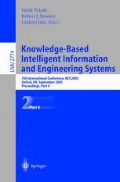Abstract
The paper presents a method designed to monitor the human–to–human communication and to estimate its efficiency based on recorded audio and video. The efficiency is estimated during the communication process, based on face and body movements tracking and nonverbal audio information classification. The members of the communication process are temporally classified as senders and receivers for short time intervals, since the role in the process usually changes in time. For our experiments we consider the situations of communication that is intended by their members (intentional) and that can be observed as main activity (primary communication) like project meetings, lectures or academic debates, where people join the discussion and the direction of information (knowledge) flow can be evaluated.
Access this chapter
Tax calculation will be finalised at checkout
Purchases are for personal use only
Preview
Unable to display preview. Download preview PDF.
References
Itou, J., Kakusho, K., Minoh, M.: Observing Human Faces in Communication to Understand the Atmosphere. In: Proceedings of 7th Pacific Rim International Conference on Artificial Intelligence, Tokyo, pp. 30–33 (2002)
King, R.G.: Fundamentals of Human Communication. Macmillan Publishing Co., Inc., New York (1979)
Lee, D.D., Seung, H.S.: Learning the parts of objects by non-negative matrix factorization. Nature 401, 788–791 (1999)
Hyvarinen, A., Karhunen, J., Oja, E.: Independent Component Analysis. John Wiley & Sons, Chichester (2001)
Hershey, J., Movellan, J.: Audio-Vision: Using Audio-Visual Synchrony to Locate Sounds. In: Solla, S.A., Leen, T.K., Mller, K.-R. (eds.) Neural Information Processing Systems 12, MIT Press, Cambridge (2000)
Author information
Authors and Affiliations
Editor information
Editors and Affiliations
Rights and permissions
Copyright information
© 2003 Springer-Verlag Berlin Heidelberg
About this paper
Cite this paper
Rutkowski, T.M., Seki, S., Yamakata, Y., Kakusho, K., Minoh, M. (2003). Toward the Human Communication Efficiency Monitoring from Captured Audio and Video Media in Real Environments. In: Palade, V., Howlett, R.J., Jain, L. (eds) Knowledge-Based Intelligent Information and Engineering Systems. KES 2003. Lecture Notes in Computer Science(), vol 2774. Springer, Berlin, Heidelberg. https://doi.org/10.1007/978-3-540-45226-3_149
Download citation
DOI: https://doi.org/10.1007/978-3-540-45226-3_149
Publisher Name: Springer, Berlin, Heidelberg
Print ISBN: 978-3-540-40804-8
Online ISBN: 978-3-540-45226-3
eBook Packages: Springer Book Archive

